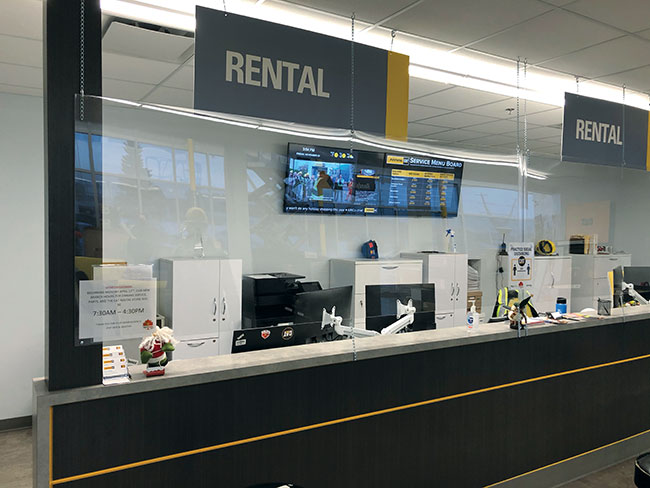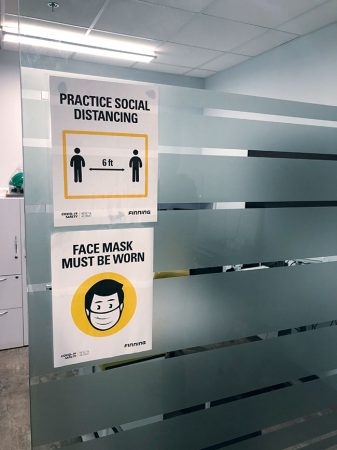
Redefining rental
By Michael Frey, rental operations manager at Finning Canada
Features Business Intelligence canada health and safety moving forward planning rentalEnsuring success in an uncertain future
 When adapting to the pandemic, a major prerogative for all rental businesses continues to be providing a safe environment for customers and employees.
When adapting to the pandemic, a major prerogative for all rental businesses continues to be providing a safe environment for customers and employees. In the rental industry, COVID-19 has changed the way everyone does business. The pandemic has forced us to find innovative ways to keep workers safe and projects moving forward. It has also accelerated tech adoption and shines a light on the opportunity for companies to see technology as a way to increase efficiencies and transform business operations.
In addition to economic impacts and changes to how rental businesses operate on a day-to-day basis, COVID-19 has also introduced a host of other challenges. These include updating health and safety practices to protect customers and employees, communicating on a frequent basis, engaging in pandemic planning, and putting resources and measures in place to ensure safety regulations are met.
Here are some pointers on how to keep workers and customers safe while ensuring business continuity for your rental operation.
New best practices
Almost overnight, the construction industry changed. At the beginning of the pandemic, rental equipment was quickly being returned and there was anxiety and concern amongst customers and stakeholders. Little could be done without extensive health and safety protocols and the ability to go on a customer’s site was drastically limited. As business quickly changed, the rental industry had to adapt.
Although many were able to move to remote working, at the field and service level it wasn’t that easy. Employees were still needed to assist customers. This required an investment to outfit branches with the tools and measures to operate safely, which included an audit of every single location. Every identifiable risk was considered. As COVID measures became the norm, there was an increased need to maximize project productivity, doubling down on not just health and safety, but scheduling and resourcing.
It is expected that pandemic protocols and procedures will continue into the near future. The number-one priority continues to be providing a safe environment for customers and employees. It’s about posting signage for safety protocols and ensuring employees are following new processes for cleaning and sanitizing equipment, including last-touch disinfecting. Plexiglass dividers were also installed between customers and staff where required, and personal protective equipment and designated rooms for quarantine were provided. Employee health pre-screening was also developed, ensuring our people remained home when experiencing any symptoms and followed the recommended public health guidelines before returning to work.
Increasing digital capabilities also helps both the rental dealer and the customer – including utilizing electronic invoices, virtual meetings when possible, and ensuring customers can view equipment online and schedule rentals from their computer or mobile app.
Use technology
For the rental industry, one of the biggest opportunities that has come from the pandemic is a greater awareness of the value of technology.
Technology has helped reduce the number of staff on site, ensuring social distancing and compliance with health and safety regulations. It has emerged as the solution to many issues for the rental business, ensuring information, processes, software systems and equipment are all working together to provide an in-depth view into what is happening on the jobsite.
There has also been an increased focus on the benefits of telematics and remote monitoring for rental equipment as it can provide even greater insights including quick, reliable, data-based technical troubleshooting, without putting anyone at risk. This also includes personalized maintenance reports, monitoring fuel efficiency, helping to track equipment, collecting data on operator behaviour and supporting maintenance scheduling to reduce downtime. Remote monitoring will experience even broader adoption as we move into the future as it can help the rental business provide the right level of service through prioritization of critical repairs and the ability to review the assets’ overall health to determine scheduling of essential repairs and maintenance.
Digital training opportunities
Almost every decision on- and off-site can now be made using a phone or tablet. Technologies like virtual training tools, videos and meetings are helping both rental dealers and customers get up to speed quickly, reducing on-site visits and the time needed for training. These technologies are reliable and have brought about significant changes to the industry. As internet connectivity improves, virtual training is expected to continue to be used even after lockdowns end. Advancements in virtual training can help better support customers meaning operators can experience exactly what they would if they were on a site, but from a safe and controlled environment. And as the workforce changes and a new generation of workers enter the industry, there will be an even better understanding and acceptance of technology.
The adoption of online business tools has been another positive change. Customers are researching equipment online more than ever and are using social media to initiate interactions with their dealership. LinkedIn, Instagram and Facebook have become important platforms in terms of connecting and working with customers, and we anticipate this will continue to be a part of the way business is done going forward.

Rental businesses have the opportunity to offer the convenience, flexibility and services that customers expect even though restrictions are in place to ensure safety.
Prioritize relationships
Customer service is an essential part of every rental business, especially in-person interactions and relationships. When customers started to restrict non-essential access to their locations, it presented many challenges. It meant greater barriers to secure new business and gather information on site, to understand the customers’ needs and support them with maintenance and repairs.
Even with restrictions still in place there are opportunities to provide the flexibility, convenience and peace of mind customers are accustomed to receiving with rental. Digital tools can be used to help track and monitor equipment and check the status of ordered parts and, as a result, streamline the business process. Online equipment rental is another way to provide convenience for customers while keeping face-to-face interactions to a minimum. Customers can get immediate quotes without having to search through multiple listings or call numerous vendors. It can also save administrative time by keeping everything in one place, including order information and rental history, allowing customers to quickly modify their fleet to stay on top of business needs.
A rental strategy
Availability and utilization are key factors for customers who often have varying daily, weekly and monthly equipment needs. Having the right equipment available at the right time and the right cost can help companies balance workflow, giving them the ability to scale up or down as needed. As a dealer, you should think about how you can support your customers. Try to understand their business needs so you can provide suggestions, advice and help develop an overall fleet strategy that encompasses rental equipment.
When customers have a solid rental strategy in place it can help them manage their fleet and keep equipment costs down. For customers who are worried about business fluctuations and machines sitting unused on a site, rental can help minimize the risk. This is particularly relevant to customers right now with the level of uncertainty about the pandemic and how it will affect upcoming work and investment in industry sectors.
The silver lining
There is a sense of optimism as we move through the new year. Last year presented the rental industry with numerous challenges and, as a result, an opportunity to think of new ways to do business while meeting customer needs. Ensuring health and safety protocols were met was the number-one priority, while at the same time supporting business continuity.
Having been through ups and downs before, the rental industry rose to the challenge. For future success it will be crucial to support customers by ensuring they have access to the equipment and technology they need to keep their operations running while at the same time staying flexible as business demands change.
Print this page
Leave a Reply